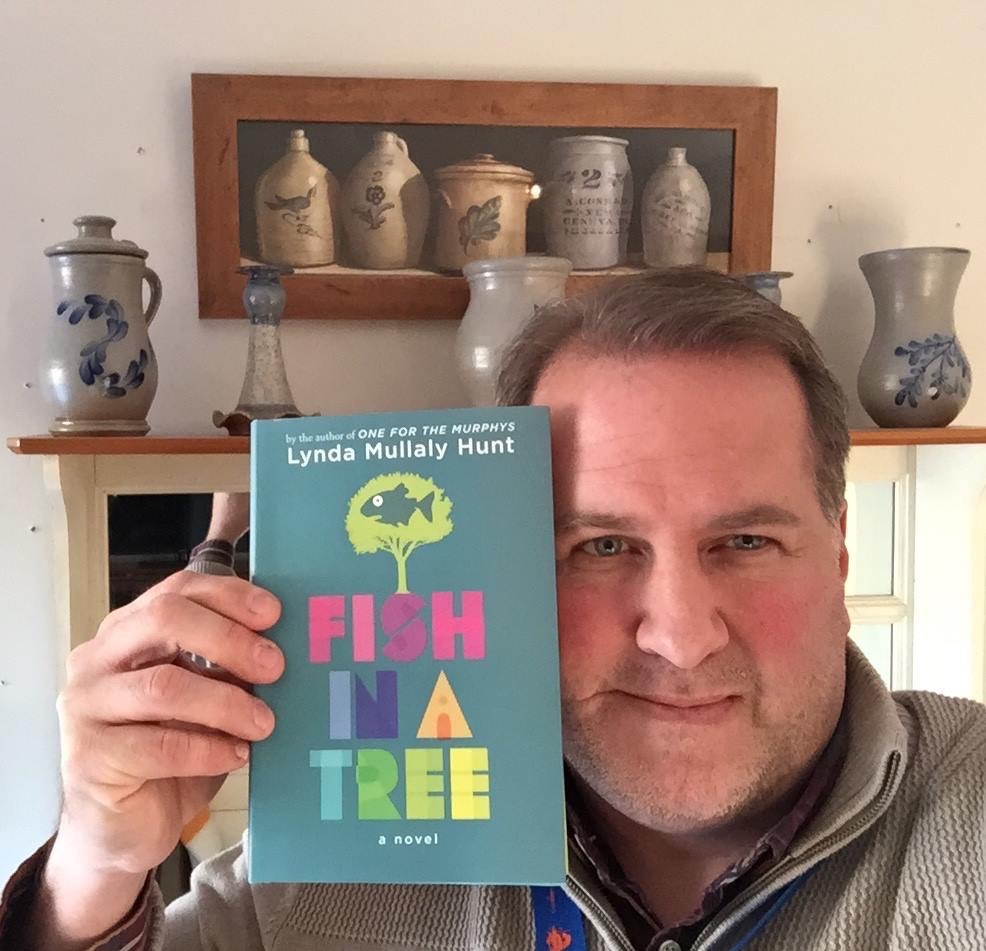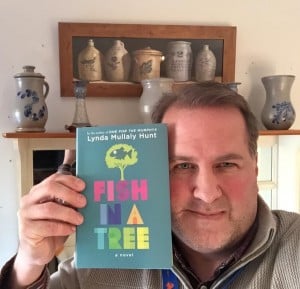It’s one of the rare pleasures of being a part of a large reading community to receive a book a little earlier than its release date. This was the case with FISH IN A TREE by Lynda Mullaly Hunt. Nancy Paulsen made sure that I had a copy of this book as far back as what felt like summer (but it couldn’t have been that early, could it?) One of the downfalls of holding a book this early is that one really should wait until closer to the release date to begin to celebrate that book. Such is the business of ARCs and early releases. What’s now new to the reading public is somehow a little “older” on your shelf. The mark of a great book for me is when I cannot wait to dash to the shelf to pull it down on its book birthday to share it with the world.
But when I came out to celebrate this release of this book on Thursday, here is what I found: lots and lots of internet buzz and love already out there. And my heart couldn’t be happier for Lynda Mullaly Hunt or for her book.
FISH IN A TREE is the sophomore title by an up-and-coming, already-there author whose first title, ONE FOR THE MURPHYS captured the hearts of lead readers and their charges across the country. We could make an argument to let the two books be celebrated apart for their own merit, but in having read both of the author’s books, I can tell you that to read them both is to see the author’s heart and then to look deeper to see how that author’s heart is developed. What I mean is this. If ONE FOR THE MURPHYS is a story that is reprsentative of Hunt’s “heart-view” of the world, then FISH IN A TREE is the prequel which shares how that view was born, nurtured, and developed.
It may not be fair to share in a review for fear of reviewer bias, but I have had some short conversations with the author which really help me to appreciate in new, insider-but-insightful ways the heart of FISH IN A TREE. Hunt’s newest book follows a plucky young lady, Ally Nickerson who finds herself in a sort of transition that many students face each year. Her teacher is leaving for maternity leave and she will have a new teacher in the room on Monday. The perfect set-up for these kinds of stories is that “who is the new nanny that’s coming” kind of approach, but Hunt makes it work here to demonstrate more than a change of leadership. This is a swing for a student who has had difficulty in the past. This is a fork in the road for a fish in a tree. It’s the Call to Adventure so familiar to students and fans of the Hero’s Journey.
If the best approach to character conflict is to drive that character up a tree and throw stones at him or her, Hunt’s story takes aim at this tree-mounted fish with a variety of familiar, sometimes-set-in-stone situations that do not call up incredulity for readers. We know Ally right away. We may not know all of the details of her life which unfold in the narrative later, but Hunt puts us into the tree’s canopy with the opening chapters wherein Ally is asked to write a letter to her new teacher and she creates a faux-paus in her attempt to send her old teacher off to maternity leave. Comic and tragic altogether, the first ten pages of FISH IN A TREE make you laugh uncomfortably at Ally’s antics as our empathy for her is just starting to warm by the end of the second chapter.
And the reader still has over two-hundred and sixty pages to go. This is the kind of book that Hunt has written here. It’s a heart book.
You send that fish up a tree and you throw stones at her. Ally’s father is a deployed tank commander which puts him out of the picture for most of the book. Her mother works at a local restaurant which becomes a sort of after-school rendevous and refuge for Ally, even when antagonists are able to patronize the same eatery. Whispered one-liners in the classrooms and cafeteria asides are part of the outside voices that work in chorus to affirm Ally’s inner voice.
Within Hunt’s plucky protagonist, we see little slivers of hurt and disappointment, but the author weaves in plenty of silver in moments of humanity and celebration throughout the story which helps us all to avoid the slow-clap ending of a book that makes us wait to have our heart strings plucked. This is what Hunt has created here. A story the reader feels that they can laugh in. . .they can love in. . .they can learn in. . and they can live in. FISH IN A TREE is truly a super example of what I would call a THESE 4 CORNERS kind of book. Within the four corners of a classsroom, a community. . .and a chessboard, Hunt has given us plenty of moments and members to celebrate through the reading of the book.
What Hunt has done in FISH IN A TREE is to create a cast of characters that make you feel like you are really a part of a classroom community as the reader. This is The Bad News Bears where you cheer for the team. This is The Goonies where you cheer for the neighborhood outcasts. Oliver, Albert, Keisha, Suki. . .Mr. Daniels. They are all in attendance and the reader is just waiting for the call to pull out his or her own vocabulary book for the day’s lesson. In this regard, Hunt has recreated what makes these kinds of books so popular with teachers and students alike. This is Rob Buyea’s Because of Mr. Terupt. This is R.J. Palacio’s Wonder. This is Kate Messner’s Marty McGuire series. This is your favorite Patricia Polacco book. We, the lead readers, pick these books up because we see ourselves in them. And if we don’t, we really want to.
What Lynda Mullaly Hunt has done with FISH IN A TREE is give classroom teachers an opportunity to revisit the Vivian Gussin Paley titles of the early 90’s. Titles like You Can’t Say You Can’t Play and The Girl with the Brown Crayon. These intimate looks into the classroom as a community of not only pupils but personalities would make wonderful teacher resources to “ladder” with FISH IN A TREE as conversations begin to develop around how we meet the needs of the Allys within our learning communities but also offering interventions and supports for the Shays.
In the time that you read this review, you may have already finished the first two chapters we celebrated here. For this distraction away from the book, I offer a heart-felt apology to you, the reader. But to the author of this wonderful book, I offer a heart-felt thank you. Thank you for letting me share the time I built a cumbersome wooden-board game with sliver-edged pieces if only to garner the favor of my fifth-grade English teacher. When I shared that story, I could still feel the chill of the breeze from the hardened branch upon which I sat in memory. But you showed me the leafiness of the story when you shared your own story with me. A twig can carry many leaves. Those leaves make a bunch. And a bunch of leaves eventually creates a canopy.
Lynda Mullaly Hunt–your book will draw readers out from the safety of the bark out onto the branch. A fish could do well here. A classroom of fish would thrive here. A school of fish. . .


Hey, Paul! First of all, you’re a hard act to follow re: writing! Thank you so very much for this layered and thoughtful review of FISH IN A TREE. This means the world to me. I am/have been grateful for your support for a long time now. It was such a pleasure and honor to *finally* meet you at NCTE. Hope our paths cross again soon, friend! ~Lynda